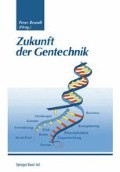Zusammenfassung
In den letzten 50 Jahren hat sich die Weltbevölkerung verdoppelt. Heute teilen sich 5,6 Mrd. Menschen die Ressourcen der Erde. In fünf Jahren werden es 6,3 Mrd. und im Jahr 2025 über 8 Mrd. sein. Eine Generation später wird sich die Menschheit dann erneut verdoppelt haben.
Access this chapter
Tax calculation will be finalised at checkout
Purchases are for personal use only
Preview
Unable to display preview. Download preview PDF.
Author information
Authors and Affiliations
Editor information
Editors and Affiliations
Rights and permissions
Copyright information
© 1997 Springer Basel AG
About this chapter
Cite this chapter
Müllner, H., Donn, G., Rasche, E. (1997). Herbizidverträgliche Kulturpflanzen, ihre Bedeutung für Landwirtschaft und Umwelt. In: Brandt, P. (eds) Zukunft der Gentechnik. Birkhäuser, Basel. https://doi.org/10.1007/978-3-0348-6108-3_5
Download citation
DOI: https://doi.org/10.1007/978-3-0348-6108-3_5
Publisher Name: Birkhäuser, Basel
Print ISBN: 978-3-7643-5662-0
Online ISBN: 978-3-0348-6108-3
eBook Packages: Springer Book Archive

